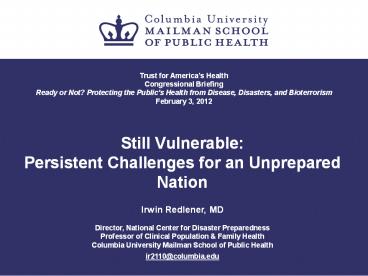Still Vulnerable: Persistent Challenges for an Unprepared Nation - PowerPoint PPT Presentation
1 / 25
Title:
Still Vulnerable: Persistent Challenges for an Unprepared Nation
Description:
Title: Slide 1 Author: Ian Lapp Last modified by: iredlener Created Date: 1/13/2005 8:54:32 PM Document presentation format: On-screen Show (4:3) Company – PowerPoint PPT presentation
Number of Views:80
Avg rating:3.0/5.0
Title: Still Vulnerable: Persistent Challenges for an Unprepared Nation
1
Still VulnerablePersistent Challenges for an
Unprepared Nation
Trust for Americas HealthCongressional
Briefing Ready or Not? Protecting the Publics
Health from Disease, Disasters, and
BioterrorismFebruary 3, 2012
Irwin Redlener, MD Director, National Center for
Disaster Preparedness Professor of Clinical
Population Family HealthColumbia University
Mailman School of Public Health ir2110_at_columbia.e
du
2
Five Major Concerns
3
1. Havent defined/ benchmarked basic termsWhat
is prepared?Who is prepared?
4
Goal A disaster-prepared, less vulnerable
population via reduced risk, increased resiliency
and improved response and recovery
5
Vulnerable populations
- Achilles heel(s) of disaster response
6
How Many?
- Children 75 million
- gt 65 40 million
- Significant chronic illness gt120 m
- People with disabilities, 21 64 22 m
- Living in poverty 44 million
- Undocumented gt 11 million
- Prison population gt 2 million
- Nursing homes 1.5 million
- VI/Ps ? Probably gt 50 of U.S.
7
- 2. Challenges of implementing national
preparedness agenda in a federalist society
8
Random Acts of Preparedness
2001-Present
9
3. Growing deficiencies in public health
emergency response workforce
10
The Workforce Gap
A Mandate to Prepare As Resources Decline
- 23,000 jobs at state and local public health
agencies from 2008-09 - 50,000 fewer workers over the last 20 years
- 50 of workforce able to retire in 2012
- 80 of public workers have not had formal
training for their jobs
11
4. Failure of imagination/ inability to think at
scale
12
Concern is not about large emergencies or
small disasters
- These generally manageable by local or regional
resources - issue is about prevention of and response to
megadisasters
13
Megadisaster
- A catastrophic, high-consequence event,
irrespective of etiology, that overwhelms or
threatens to overwhelm local and regional
response capacity. Indicators may include - Inability to manage immediate rescue of
endangered survivors - Significant backlog of victims unable to get
appropriate medical care or other essential
support - Inability to protect vital infrastructure or
prevent significant property destruction - Uncontrolled societal breakdown
14
(No Transcript)
15
10 KT Nuclear detonation in NYC
- Living casualties
- Delayed 20 74,000
- Immediate 20 64,000
- Minimal 40 148,000
- Expectant 20 74,000
16
lt 40,000
- Total hospital beds in NY State?
17
17
18
(No Transcript)
19
Pandemic Flu in NYC Assumptions
- Population of 8.2 million
- H5N1 attack rate 30
- Hospitalization rate 10
- Mortality rate 2.5 of those infected
- Six month flu season
20
Potential Realities
- 2.4 million people sick (including 600,000
children) with avian flu - 60,000 deaths (includes 15,000 children) 200,000
hospital admissions - More than 300 deaths/ day
- Not enough Vaccine, antiviral meds (tamiflu),
hospital beds, ventilators, etc. - plus schools closed, many parents ill, potential
quarantines, economy in trouble, little
assistance from the outside, etc.
21
- 5. Growing and dangerous disparity between
needs and resources - (honey, I shrunk the preparedness budget)
22
Preparedness Funding Crisis
- Preparedness and Response Funding at HHS and DHS
fell 17 from FY10 to FY11, a drop of 900M from
5.3B to 4.4B - -13 Public Health Emergency Preparedness Grants
to State and Local Health Departments (HHS) - -40 Academic Public Health Preparedness Centers
(HHS) - -11 Hospital Preparedness Programs a 35
decrease over the last 5 years (HHS) - -58 Regional Catastrophic Grant Preparedness
Program (DHS) - -75 Emergency Operations Center Grant Program
(DHS) - -28 Homeland Security Grant Program the
centerpiece of state and local homeland security
funding (DHS)
23
Why?
- Recession ? Austerity
- Deferring insurance/ wont happen on my watchI
hope - Extreme silo-ization
- Small, non-empowered constituency (who actually
cares?)
24
Whats needed
- Political Leadership and Investments
- Federal Budgets must reinvest and sustain funding
at DHS and HHS - Pass and fund PAHPA, HS Reauthorization
- Restore and expand funding to key regional
programs like RCGP - Restore and expand funding to key hospital and
public health programs - Adopt recommendations of National Commission on
Children and Disasters - Assume direct leadership for expanding medical
counter-measure innovations - Academic Partnerships
- Academia must provide training, research, and a
new workforce - Restore funding to Academic Public Health
Preparedness Centers - Invest in new Centers of Excellence
- Public Preparedness
- Individuals and families must be ready for
disasters - Make into law the recommendations of the NCCD
- Rethink public messaging
25
or, roll the dice































